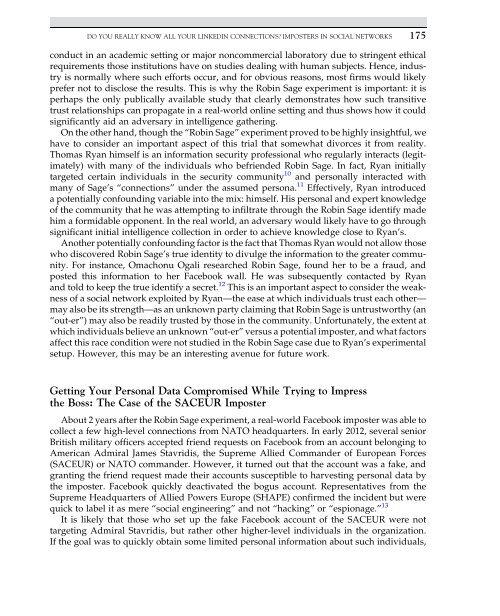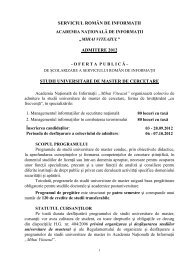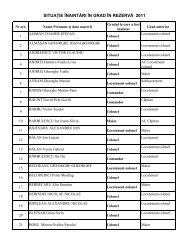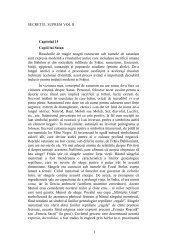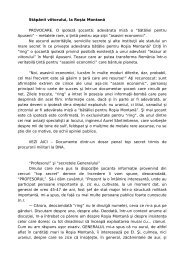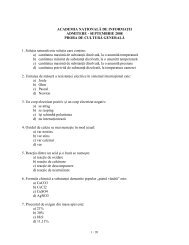Introduction to Cyber-Warfare - Proiect SEMPER FIDELIS
Introduction to Cyber-Warfare - Proiect SEMPER FIDELIS
Introduction to Cyber-Warfare - Proiect SEMPER FIDELIS
Create successful ePaper yourself
Turn your PDF publications into a flip-book with our unique Google optimized e-Paper software.
DO YOU REALLY KNOW ALL YOUR LINKEDIN CONNECTIONS? IMPOSTERS IN SOCIAL NETWORKS175conduct in an academic setting or major noncommercial labora<strong>to</strong>ry due <strong>to</strong> stringent ethicalrequirements those institutions have on studies dealing with human subjects. Hence, industryis normally where such efforts occur, and for obvious reasons, most firms would likelyprefer not <strong>to</strong> disclose the results. This is why the Robin Sage experiment is important: it isperhaps the only publically available study that clearly demonstrates how such transitivetrust relationships can propagate in a real-world online setting and thus shows how it couldsignificantly aid an adversary in intelligence gathering.On the other hand, though the “Robin Sage” experiment proved <strong>to</strong> be highly insightful, wehave <strong>to</strong> consider an important aspect of this trial that somewhat divorces it from reality.Thomas Ryan himself is an information security professional who regularly interacts (legitimately)with many of the individuals who befriended Robin Sage. In fact, Ryan initiallytargeted certain individuals in the security community 10 and personally interacted withmany of Sage’s “connections” under the assumed persona. 11 Effectively, Ryan introduceda potentially confounding variable in<strong>to</strong> the mix: himself. His personal and expert knowledgeof the community that he was attempting <strong>to</strong> infiltrate through the Robin Sage identify madehim a formidable opponent. In the real world, an adversary would likely have <strong>to</strong> go throughsignificant initial intelligence collection in order <strong>to</strong> achieve knowledge close <strong>to</strong> Ryan’s.Another potentially confounding fac<strong>to</strong>r is the fact that Thomas Ryan would not allow thosewho discovered Robin Sage’s true identity <strong>to</strong> divulge the information <strong>to</strong> the greater community.For instance, Omachonu Ogali researched Robin Sage, found her <strong>to</strong> be a fraud, andposted this information <strong>to</strong> her Facebook wall. He was subsequently contacted by Ryanand <strong>to</strong>ld <strong>to</strong> keep the true identify a secret. 12 This is an important aspect <strong>to</strong> consider the weaknessof a social network exploited by Ryan—the ease at which individuals trust each other—may also be its strength—as an unknown party claiming that Robin Sage is untrustworthy (an“out-er”) may also be readily trusted by those in the community. Unfortunately, the extent atwhich individuals believe an unknown “out-er” versus a potential imposter, and what fac<strong>to</strong>rsaffect this race condition were not studied in the Robin Sage case due <strong>to</strong> Ryan’s experimentalsetup. However, this may be an interesting avenue for future work.Getting Your Personal Data Compromised While Trying <strong>to</strong> Impressthe Boss: The Case of the SACEUR ImposterAbout 2 years after the Robin Sage experiment, a real-world Facebook imposter was able <strong>to</strong>collect a few high-level connections from NATO headquarters. In early 2012, several seniorBritish military officers accepted friend requests on Facebook from an account belonging <strong>to</strong>American Admiral James Stavridis, the Supreme Allied Commander of European Forces(SACEUR) or NATO commander. However, it turned out that the account was a fake, andgranting the friend request made their accounts susceptible <strong>to</strong> harvesting personal data bythe imposter. Facebook quickly deactivated the bogus account. Representatives from theSupreme Headquarters of Allied Powers Europe (SHAPE) confirmed the incident but werequick <strong>to</strong> label it as mere “social engineering” and not “hacking” or “espionage.” 13It is likely that those who set up the fake Facebook account of the SACEUR were nottargeting Admiral Stavridis, but rather other higher-level individuals in the organization.If the goal was <strong>to</strong> quickly obtain some limited personal information about such individuals,


